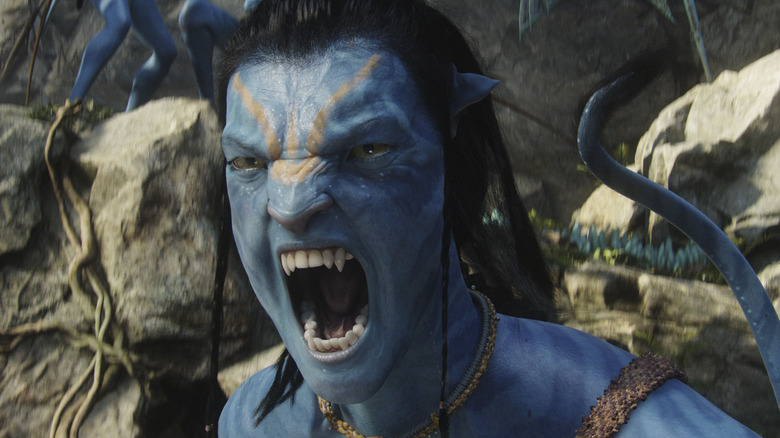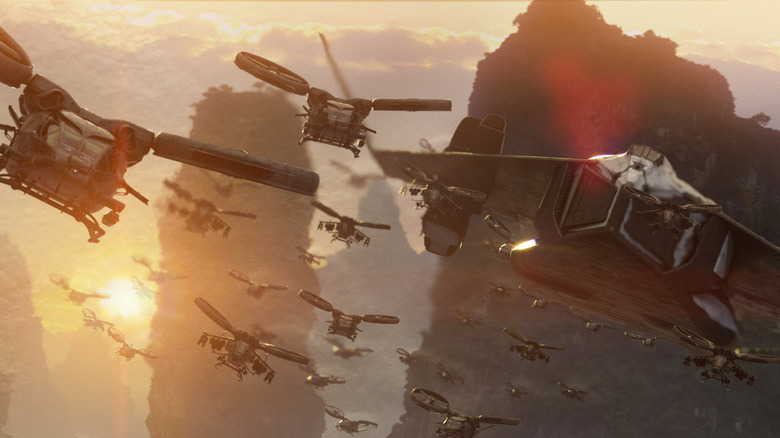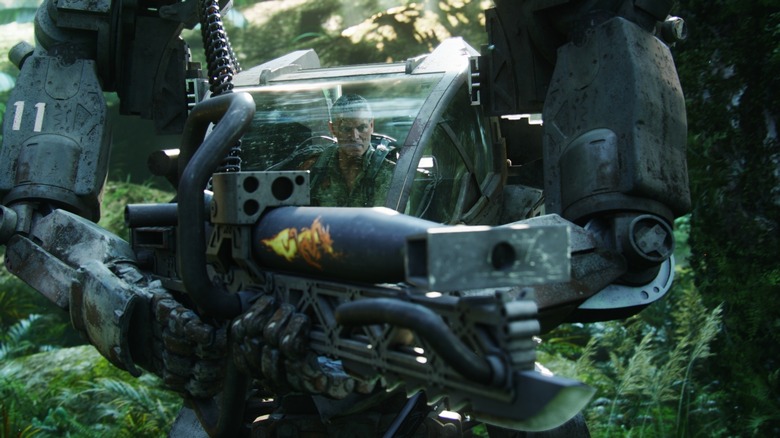The Climax Of Avatar Is The Best Action Scene Ever
(Welcome to Best Action Scene Ever, a column dedicated to breaking down the best, most effective action sequences throughout the genre. In this edition, we take to the skies for the climactic battle between the indigenous Na'vi and human military invaders in 2009's "Avatar.")
Sometimes, being the highest-grossing film of all time ain't all it's cracked up to be.
The reputation of James Cameron's "Avatar" seemed straightforward enough upon its release in 2009, rapidly turning into a word-of-mouth sensation and displaying a historically strong staying power week-in and week-out the likes of which we've rarely seen before — well, not since Cameron's own "Titanic," that is. But shock and awe at the otherworldly images of the tropical moon Pandora and the blue-skinned Na'vi who called it home steadily turned into something else entirely after the film finally wrapped up its lengthy theatrical run and, according to a vocal group of detractors, subsequently dropped off the map entirely in terms of "pop culture impact." As the years went by without any movement on a sequel, the derision only increased in volume and voracity until the blockbuster that took the world by storm eventually became known more as a punchline than anything else.
But, as fate would have it, that was hardly the end of the story. 2022 saw the long-delayed sequel finally come to fruition and a harsh lesson delivered to those who foolishly thought that they could ever bet against James Cameron. The runaway success of "Avatar: The Way of Water" speaks for itself, but it's also provided an excuse to return to the one that started it all and grapple with the finer points of the original movie.
Well over a decade removed from "Avatar," the strengths (and shortcomings) of the picture are as clear as can be. The rather generic storyline and the noticeable stench of white saviorism can't help but stick out as elements to be improved upon, but even the biggest skeptics can hardly deny the one tool in Cameron's arsenal that he could deliver in his sleep: the action. With this new column, we're going to kick things off with an in-depth look at the climactic battle sequence of "Avatar" to break down what worked, why, and how it stands the test of time.
The scene
Let nobody ever say that James Cameron doesn't come through when it counts. The filmmaker behind classics such as "Aliens," "Terminator 2," and "Titanic" has made a career out of delivering on the spectacle that audiences expect from him, and "Avatar" is no exception. After spending fully half the film integrating Jake Sully (Sam Worthington) into the culture of Neytiri (Zoe Saldaña) and the rest of the Na'vi, Cameron finally unleashes all the action viewers could want — and then some.
After destroying the Hometree and scattering the obstinate natives, Stephen Lang's villainous Colonel Quaritch instigates one last major offensive to break the will and spirit of the people for good. The plan involves humanity's heavily militarized Resources Development Administration (RDA) venturing into the treacherous Hallelujah Mountains of floating rock structures, locating the sacred Tree of Souls that serves as the heart of Na'vi tribe, and wiping it out. Resolved to fight against this final affront to their beliefs at all costs, which would sever their connection with Eywa (the mother goddess deity that represents all life on Pandora), Jake inspires the scattered clans to unite and take the fight to the RDA.
The result, essentially, is a deceptively complicated 20-minute sequence that takes the action from the skies above Pandora to the jungles below in as ambitious and thrilling a set piece as you'll ever see.
Why it works
How filmmakers use action can say a lot about how they view their audiences. Throwing as many set pieces at the screen as they can in as short an amount of time as possible tends to betray either a lack of confidence in a script or in the attention span of their target demo (or both). Instead, Cameron skillfully holds back on any real armed conflict until more than halfway through "Avatar." By framing the inevitable clash between human and Na'vi as a slow-motion tragedy, our first taste of war in the second act comes as a gut punch and ends with Jake Na'vi suffering their most major setback yet: the cruel, senseless destruction of their sacred Hometree by Quaritch's far superior force.
So when the final act rolls around, the combination of the stunning defeat, Neytiri turning on Jake for the part he played in the destruction, and Dr. Grace Augustine's (Sigourney Weaver) death means Cameron has effectively put viewers back on their heels and desperate for a much-needed hint of triumph. What follows is an expertly-guided tour through our own emotional peaks and valleys. With Jake thrust into a leadership position (thanks to his little stunt that earned him the title of Toruk Makto) and the call sent out for reinforcements, the Na'vi organize a multi-pronged defense to truly fight back for the first time since humanity occupied their world.
Here, Cameron uses every trick at his disposal to wring as much tension, stakes, and heart out of the action as he can. The framing by Cameron and director of photography Mauro Fior establishes a clear sense of geography at every turn, allowing the plot to unfold with cause-and-effect storytelling and a series of setups and payoffs. The aerial attack amid the floating mountains ramps up the mayhem and spectacle of it all, killing off multiple supporting players (RIP Michelle Rodriguez's pilot Tracy and Laz Alonso's Tsu'tey, Jake's rival for Neytiri's affections) and ultimately leading to Jake, Neytiri, and Quaritch all ending up on the ground. This, as it turns out, is where the real magic happens.
The key moment
Action is as much about the emotions of the moment as it is the actual flow of the sequence.
In "Avatar," both are accomplished thanks to the work of Cameron and editors John Refoua and Stephen Rivkin as they crosscut between the various arenas of the climactic fight. Never once losing track of the main story focus (preventing the RDA from delivering their explosive payload against the Tree of Souls) and the personal stakes of Jake and Neytiri versus Quaritch, our attention is pulled into multiple directions without ever becoming distracting. There's the visceral aerial attacks between the RDA aircraft and the Na'vi atop their pterodactyl-like Ikran, the ground-level clash between soldiers in those mech AMP suits and Na'vi riders on horseback, and the show-stopping moment when it appears as if Eywa itself rises up against Pandora's invaders to unleash its wildlife into the fray — as perfect a marriage between action and theme as it gets.
Everything builds to the hand-to-hand fight against Quaritch, who witnessed (and narrowly escaped) the failure of his disastrous air campaign and is now seemingly out for Jake's blood with nothing left to lose. Impressively, Cameron shrinks the scope of the otherwise sprawling climax to this one small stretch of jungle and these three main characters because, as much as spectacle reigns supreme elsewhere in "Avatar," Cameron also understands that we have no reason to be invested if it doesn't all boil down to character. One brutal fight and a last-minute save by Neytiri later, the enemy is vanquished (or is he???) and a battle sequence that could've resulted in sensory overload to the extreme is instead brought to a satisfying close.
More than most, Cameron recognizes that action never need be an impediment to everything else a storyteller tries to accomplish. Perhaps more than any other segment of the film, the climax of "Avatar" brings all the emotion, character, and, yes, spectacle to the fore in a beautifully rendered sequence that would only be topped by its own sequel. Even with "The Way of Water" upping the ante considerably (in a manner of speaking, at least), it's worth celebrating the workmanlike pleasures of the action in "Avatar," too.


